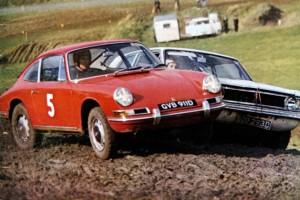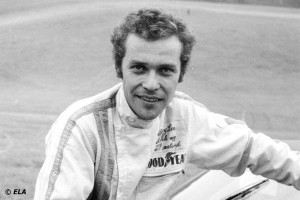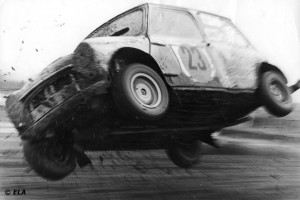For more than 30 years some people keep on claiming that the motorsport of Rallycross owes its existence to either a 1963 Rallysprint-type event held at the car parks of Brands Hatch Circuit, or to the outbreak of the foot-and-mouth disease in the UK – or even to both. All utter nonsense! Rallycross was born at Lydden Hill, already nine months before the 1967 RAC Rally was cancelled due to FMD. And it was not born for the BBC ‘Grandstand’ cameras, as often claimed, but for an ITV programme called ‘World of Sport’.
Apropos Lydden Hill: At the eve of the 2013 RallycrossRX opener in England I found a story on a serious Rally website that came over me like a blast from the past. I’ve read the same nonsense again that I’d once found in the Official Programme of the first ever British Rallycross Grand Prix at Brands Hatch, in December of 1982. A story eventually revealed to be all wrong in early 1992, when the 25th anniversary of Rallycross has been celebrated at Lydden Circuit, the cradle of the sport. Proved to be wrong by my British press colleague Tim Whittington, who by then was able to find the true fathers of Rallycross again. And they have told him how our motorsport came really into being.
I do not know who wrote that 1982 article under the title “Rallycross in the past”, but it was nothing but a poorly researched try to connect Brands Hatch with the birth of Rallycross. Quote: “Brands Hatch has a long association with the Sport of Rallycross, for it was here, nearly 20 years ago, that the first event of the type was staged. Following the late cancellation of the RAC Rally in 1963…” A picture caption reads: “Rallycross is conceived in the fog and snow at Brands Hatch in December 1963.”
What’s wrong with the uncredited writer’s sorry effort? An easy and quick research shows that the 1963 RAC Rally has not been cancelled at all, but was won by the Swedish team Tom Trana and Sune Lundström in their Volvo PV 544. The so-called ‘Mini-Monte’ in the Brands Hatch car parks was held in February 1963, and not in November or December of that year. However, the article goes on claiming that a Rallysprint-type event was set up after the RAC Rally was cancelled due to outbreak of foot-and-mouth disease. And that its replacement on Brands Hatch soil should be seen as the very event that Rallycross came into being.
As a matter of fact it was the 1967 RAC that happened to be cancelled because of FMD, and that was no less than nine months after the first ever true Rallycross took place at Lydden Hill in February 1967. So why should a 1963 event, that featured one car at a time fighting against a muddy track as well as the timekeeper’s clock, and the cancelled RAC Rally 1967 have any connections with the real birth of Rallycross? Maybe it is just because the made-up story was good for Brands Hatch then – and reads rather more interesting than the truth for a lot of people ever since…
First public mentioning of the term Rallycross
On January 20 1967 there was a little piece of news to be found in the ‘Pit & Paddock’ section of the British magazine Autosport: “A new form of motor sport has been thought up by John Sprinzel, Barrie Gill of the Sun and Robert Reed of ABC TV’s World of Sport. Called Rallycross, the sport is open only to rally cars. The first event will be organized by the Tunbridge Wells Centre of the 750 MC at Lydden Hill on 4th February, and will involve speed tests on the circuit itself and rough stuff on surrounding grass areas. Entries so far include Peter Harper (Sunbeam Imp Sport), Tony Fall (Mini-Cooper S), John Sprinzel (MG Midget) and Eric Hassell (Sunbeam Imp Sport), and the event will be covered by ABC TV.”
Note: It is very important to mention two other men here. Without Bud Smith († 1994), who organised the event and devised the new format of short timed races, and Lydden Circuit owner Bill Chesson († 1999), who encouraged Smith and provided the first Rallycross track, the ideas of Robert Reed would have come to nothing. Sprinzel (according to Reed and Smith the creator of the name Rallycross, which had never been used before and is a blend of Rally and Autocross) and Gill’s roles are somewhat overrated by this Autosport snippet. Both were only involved after Reed, Smith and Chesson had already done the groundwork.
Born for the TV cameras
The first ever true Rallycross event was held at Lydden Circuit, halfway between the towns of Canterbury and Dover (County Kent) in England, on Saturday February 4 1967. The Tunbridge Wells Centre of the 750 Motor Club organised the event for ABC Television which needed an easily televised all-weather motorsport to fill gaps (due to cancelled horse races during the winter) for its World of Sport programme. The daddies of this new racing breed were television producer Robert Reed of ITV and event organiser Bud Smith, the 750 MC’s TWC Vice-Chairman backed by his club’s Chairman Martin Wright and Secretary Barry Lawson, while venue owner Bill Chesson prepared and placed Lydden Circuit at their disposal. Help on the day came from Dick Mullins and the Tunbridge Wells Motor Club (TWMC), as it was a much too big undertaking for the rather small 750 MC section to handle all things by themselves.
The Rallycross maiden event was open to a group of invited competitors from the world of rallying and featured races between four cars at a time (starting abreast!) over a track consisting of gravel, grass and tarmac surfaces. It was won by the arguably most versatile ‘all-round pilot’ in the history of car racing, the 1968 Monte Carlo Rally winner as well as Formula 1 and sports car driver Vic Elford, using a showroom Porsche 911 from importer AFN. Runner-up to “Quick Vic” became Brian Melia (Ford Lotus-Cortina) while third place was claimed by Tony Fall (Mini Cooper S).
Although most of the by then completely unprotected cars were badly damaged (headlamps, windscreens, bonnets, mirrors, etc. broke or were knocked off) the new sport proved immediately quite successful with the organisers, the factory teams and the TV makers as well as viewers and only five weeks later the second event was arranged on March 11 at the Kentish venue. Due to an argument with their head office Bud Smith & Co. split with 750 MC during the year and they moved the organising team to the Kentish Border Car Club (KBCC) who then started to run the Rallycross events at Lydden.
After another test race, on July 29, the fourth event, on September 23, marked also Round 1 of the World of Sport Rallycross Championship, followed by Round 2 on October 7. The first international Rallycross at Lydden Hill took place on Saturday November 25, but lost its foreign entrants at the eleventh hour when an epidemic of foot-and-mouth disease caused the preceding RAC Rally to be cancelled.
Some of the foreigners had also planned to take part in the 1st International Rallycross at Lydden, but went home immediately after the Rally had been cancelled on the evening of November 17, and was replaced by a single special stage for the sake of the disappointed television companies. Rally stage number one by then, Camberley, was on Ministry of Defence land and not affected by movement restrictions caused by the disease in rural areas. Therefore, it was left to the Britons to provide the Lydden Circuit show one week later and the ABC TV contest was eventually won by Andrew Cowan (Hillman Imp), ahead of Peter Harper (Hillman Imp) and Tony Fall (Austin 1800).
Thames Estuary Automobile Club’s premier event, the original TEAC Clubman’s Rallycross, was held the day after (November 26). It was this very meeting that opened up the new Rally drivers’ fun-sport to many amateur competitors and, thereby, paved the way for the first generation of real Rallycross specialists, many of them coming from the ranges of Autocross and Grass Track racing. Round 3 of ITV’s championship series was held at another track, on December 30 it was Croft Circuit in Yorkshire to become the second British venue for to organise Rallycross events.
After two more Croft races (Round 4 on February 3 1968 and Round 5 on March 9) the 6th and Final Round of the new racing series took place at Lydden where Tony Chappell (Ford Escort Mk1 TwinCam) ensured himself the first ever Rallycross Championship (1967/68) win in motorsport’s history. Second of the inaugural British RX series finished Scotsman Peter Harper (Hillman Imp) und third place was claimed by Brian Chatfield (Mini Cooper S).
1969 – Rallycross starts to conquer the European mainland
After that first ever true Rallycross, hosted on February 4 1967 at Lydden Hill, it took two more years till the new motorsport made it over to the European continent. The first official race (following a track testing day on May 17) being held on June 7 1969 on a given up WW2 airfield and military testing grounds, situated between the Dutch town of Venlo and the near border to Germany. The winner of the first ever Rallycross on the European continent was Hans Kok, who raced a well prepared and rapid NSU TT to a deserved victory over Cees Bos in a Wartburg 1000, Cees van Grieken in an Alfa Romeo 1750 and Theo Koks in a Sunbeam Imp. Subsequently three more events were organised on the concrete airstrip surrounded by heathland, all four counting towards the so-called ‘AVRO-Trophy’ series, that was eventually claimed by NSU campaigner Hans Kok during the final championship round on August 16. On Oktober 4 1969 Holland saw its last Rallycross event of the first season, a stand-alone race organised on a temporary track that was quickly set up on pastureland near the ‘Europahal’ at the town of Elst, halfway between Arnhem and Nijmegen. Here it was young Briton ‘Jumping’ Jeff Wiliamson who drove his Riley 1300 to overall victory. For 1971 the Nederlandse Rallycross Vereniging (NRV), moved the sport to its continental home at Valkenswaard near Eindhoven. The all-new Eurocircuit had its maiden event being held on April 17, won by Jan de Rooy in his amazing DAF 55 Coupé 4×4 (the so-called ‘bultje’, with dome-shaped roof extension). Thereby, the Eurocircuit became the first ever motorsports venue that was especially designed and built for Rallycross purposes.









